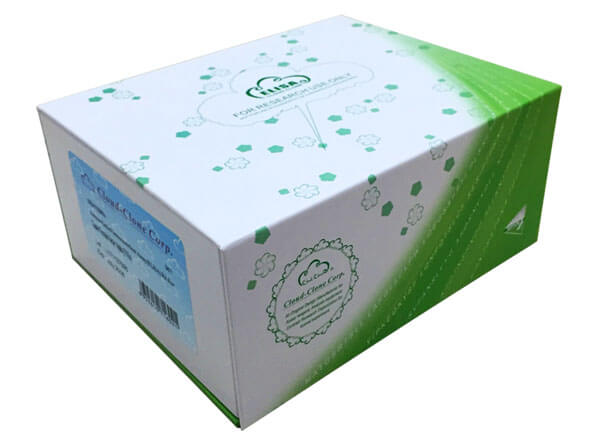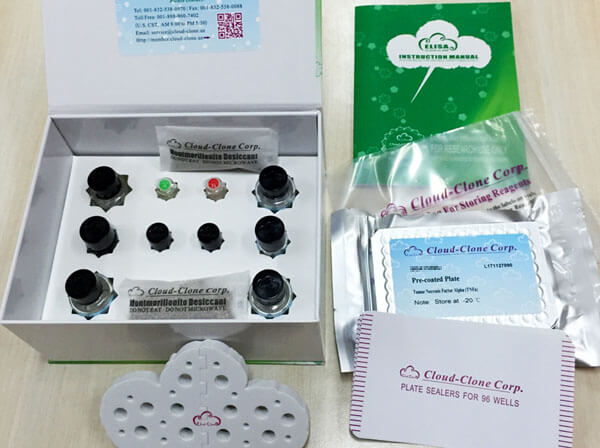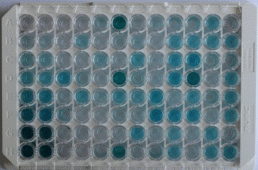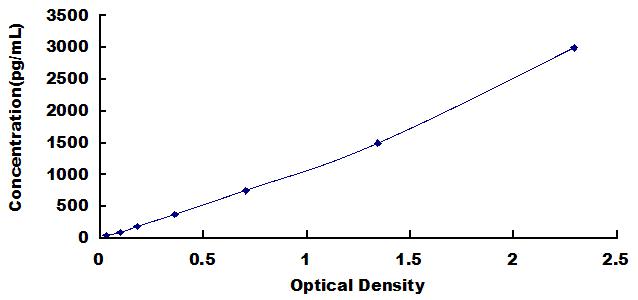表面活性物质关联蛋白A(SFTPA1)检测试剂盒(酶联免疫吸附试验法)
ELISA Kit for Pulmonary Surfactant Associated Protein A1 (SFTPA1)
PRL; SFTPA; PSAP; PSPA; SFTP; SPA; COLEC4; PSP-A; SFTP1; SFTPA1B; SP-A1; Collectin-4; Alveolar proteinosis protein; 35 kDa pulmonary surfactant-associated protein; Surfactant Associated Protein A
- 编号SEA890Hu
- 物种Homo sapiens (Human,人)相同的名称,不同的物种。
- 实验方法双抗夹心
- 反应时长3h
- 检测范围46.88-3,000pg/mL
- 灵敏度最小可检测剂量小于等于16.99pg/mL.
- 样本类型Serum, plasma, tissue homogenates, cell lysates, cell culture supernates and other biological fluids
- 下载英文说明书 中文说明书
- 规格48T96T96T*596T*1096T*100
- 价格¥ 2646¥ 3780¥ 17010¥ 32130¥ 264600
- 欲了解实际交易价格和更多情况,请与当地经销商联系!
特异性
本试剂盒用于检测表面活性物质关联蛋白A(SFTPA1),经检测与其它相似物质无明显交叉反应。
由于受到技术及样本来源的限制,不可能完成对所有相关或相似物质交叉反应检测,因此本试剂盒有可能与未经检测的其它物质有交叉反应。
回收率
分别于定值血清及血浆样本中加入一定量的表面活性物质关联蛋白A(SFTPA1)(加标样品),重复测定并计算其均值,回收率为测定值与理论值的比率。
| 样本 | 回收率范围(%) | 平均回收率(%) |
| serum(n=5) | 96-104 | 101 |
| EDTA plasma(n=5) | 98-105 | 101 |
| heparin plasma(n=5) | 80-90 | 84 |
精密度
精密度用样品测定值的变异系数CV表示。CV(%) = SD/mean×100
批内差:取同批次试剂盒对低、中、高值定值样本进行定量检测,每份样本连续测定20 次,分别计算不同浓度样本的平均值及SD值。
批间差:选取3个不同批次的试剂盒分别对低、中、高值定值样本进行定量测定,每个样本使用同一试剂盒重复测定8次,分别计算不同浓度样本的平均值及SD值。
批内差: CV<10%
批间差: CV<12%
线性
在定值血清及血浆样本内加入适量的表面活性物质关联蛋白A(SFTPA1),并倍比稀释成1:2,1:4,1:8,1:16的待测样本,线性范围即为稀释后样本中表面活性物质关联蛋白A(SFTPA1)含量的测定值与理论值的比率。
| 样本 | 1:2 | 1:4 | 1:8 | 1:16 |
| serum(n=5) | 78-91% | 93-105% | 92-101% | 78-91% |
| EDTA plasma(n=5) | 96-105% | 92-105% | 95-105% | 80-104% |
| heparin plasma(n=5) | 97-105% | 90-97% | 96-105% | 81-101% |
稳定性
经测定,试剂盒在有效期内按推荐温度保存,其活性降低率小于5%。
为减小外部因素对试剂盒破坏前后检测值的影响,实验室的环境条件需尽量保持一致,尤其是实验室内温度、湿度及温育条件。其次由同一实验员来进行操作可减少人为误差。
实验流程
1. 实验前标准品、试剂及样本的准备;
2. 加样(标准品及样本)100µL,37°C孵育1小时;
3. 吸弃,加检测溶液A100µL,37°C孵育1小时;
4. 洗板3次;
5. 加检测溶液B100µL,37°C孵育30分钟;
6. 洗板5次;
7. 加TMB底物90µL,37°C孵育10-20分钟;
8. 加终止液50µL,立即450nm读数。
实验原理
将表面活性物质关联蛋白A(SFTPA1)抗体包被于96孔微孔板中,制成固相载体,向微孔中分别加入标准品或标本,其中的表面活性物质关联蛋白A(SFTPA1)与连接于固相载体上的抗体结合,然后加入生物素化的表面活性物质关联蛋白A(SFTPA1)抗体,将未结合的生物素化抗体洗净后,加入HRP标记的亲和素,再次彻底洗涤后加入TMB底物显色。TMB在过氧化物酶的催化下转化成蓝色,并在酸的作用下转化成最终的黄色。颜色的深浅和样品中的表面活性物质关联蛋白A(SFTPA1)呈正相关。用酶标仪在450nm波长下测定吸光度(O.D.值),计算样品浓度。
增值服务
相关产品
| 编号 | 适用物种:Homo sapiens (Human,人) | 应用(仅供研究使用,不用于临床诊断!) |
| RPA890Hu01 | 表面活性物质关联蛋白A(SFTPA1)重组蛋白 | Positive Control; Immunogen; SDS-PAGE; WB. |
| EPA890Hu61 | 表面活性物质关联蛋白A(SFTPA1)真核蛋白 | Positive Control; Immunogen; SDS-PAGE; WB. |
| RPA890Hu02 | 表面活性物质关联蛋白A(SFTPA1)重组蛋白 | Positive Control; Immunogen; SDS-PAGE; WB. |
| APA890Hu61 | 表面活性物质关联蛋白A(SFTPA1)活性蛋白 | Cell culture; Activity Assays. |
| PAA890Hu01 | 表面活性物质关联蛋白A(SFTPA1)多克隆抗体 | Testing in progress |
| PAA890Hu02 | 表面活性物质关联蛋白A(SFTPA1)多克隆抗体 | WB; IHC |
| LAA890Hu81 | 表面活性物质关联蛋白A(SFTPA1)多克隆抗体(异硫氰酸荧光素标记) | WB; IHC; ICC; IF. |
| LAA890Hu71 | 表面活性物质关联蛋白A(SFTPA1)多克隆抗体(生物素标记) | WB; IHC; ICC. |
| MAA890Hu22 | 表面活性物质关联蛋白A(SFTPA1)单克隆抗体 | WB; IHC |
| MAA890Hu21 | 表面活性物质关联蛋白A(SFTPA1)单克隆抗体 | WB; IHC |
| MAA890Hu23 | 表面活性物质关联蛋白A(SFTPA1)单克隆抗体 | WB; IHC; ICC; IP. |
| WEA890Hu | 表面活性物质关联蛋白A(SFTPA1)检测试剂盒(酶联免疫吸附试验法,宽范围) | Enzyme-linked immunosorbent assay for Antigen Detection. |
| SEA890Hu | 表面活性物质关联蛋白A(SFTPA1)检测试剂盒(酶联免疫吸附试验法) | Enzyme-linked immunosorbent assay for Antigen Detection. |
| SCA890Hu | 表面活性物质关联蛋白A(SFTPA1)检测试剂盒(化学发光免疫分析法) | Chemiluminescent immunoassay for Antigen Detection. |
| LMA890Hu | 表面活性物质关联蛋白A(SFTPA1)等多因子检测试剂盒(流式荧光发光法) | FLIA Kit for Antigen Detection. |
参考文献
| 杂志 | 参考文献 |
| The American Journal of Rhinology & Allergy | Surfactant protein A and D in chronic rhinosinusitis with nasal polyposis and corticosteroid response[Ingenta: art00005] |
| American Journal of Rhinology & Allergy | Detection of surfactant proteins A, B, C, and D in human nasal mucosa and their regulation in chronic rhinosinusitis with polyps[PubMed: 23406594] |
| Plos one | Staphylococcus aureus and Pseudomonas aeruginosa Express and Secrete Human Surfactant Proteins[PubMed: PMC3551896] |
| Plos one | The Detection of Surfactant Proteins A, B, C and D in the Human Brain and Their Regulation in Cerebral Infarction, Autoimmune Conditions and Infections of the CNS[PubMed: PMC3787032] |
| Nachweis und Charakterisierung des Oberfl?chenproteins PLUNC (Palate, Lung and Nasal Clone Protein) an der Augenoberfl?che und Bedeutung für das Trockene Auge[Opus4:Source] | |
| Mol Med Rep | Expression of surfactant protein-A in exhaled breath condensate of patients with chronic obstructive pulmonary disease[PubMed: 26707652] |
| Plos One | Serum Levels of Surfactant Proteins in Patients with Combined Pulmonary Fibrosis and Emphysema (CPFE)[Pubmed:27337142] |
| PLoS One | The Cerebral Surfactant System and Its Alteration in HydrocephalicConditions.[pubmed:27656877] |
| Frontiers in Aging Neuroscience | Correlations of Ventricular Enlargement with Rheologically Active SurfactantProteins in Cerebrospinal Fluid.[pubmed:28101052] |
| Frontiers in Aging Neuroscience | Correlations of Ventricular Enlargement with Rheologically Active Surfactant Proteins in Cerebrospinal Fluid[PMC5209370] |
| American Journal of Physiology. Lung Cellular and Molecular Physiology | Chronic lung injury and impaired pulmonary function in a mouse model of acid ceramidase deficiency.[pubmed:29167126] |
| Molecular biosystems | Metabolic profiling of asthma in mice and the interventional effects of SPA using liquid chromatography and Q-TOF mass spectrometry[pubmed:28463380] |
| PLoS One | Evaluation of surfactant proteins A, B, C, and D in articular cartilage, synovial membrane and synovial fluid of healthy as well as patients with osteoarthritis and …[Pubmed: 30235245] |
| PLOS ONE | Organic barn dust inhibits surfactant protein D production through protein kinase-c alpha dependent increase of GPR116[Pubmed: 30543664] |
| Molecular Neurobiology | Elevated levels of multifunctional surfactant proteins in cerebrospinal fluid are associated with signs of increased cerebrospinal fluid flow in cranial magnetic …[Doi: 10.1007/s12035-017-0835-5] |
| Molecular Neurobiology | Rheologically Essential Surfactant Proteins of the CSF Interacting with Periventricular White Matter Changes in Hydrocephalus Patients–Implications for CSF …[Doi: 10.1007/s12035-019-01648-z] |
| Antioxidants (Basel) | Oxidative Stress and Inflammatory Mediators in Exhaled Breath Condensate of Patients with Pulmonary Tuberculosis. A Pilot Study with a Biomarker Perspective[34679707] |





